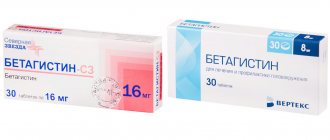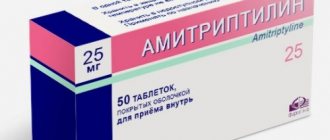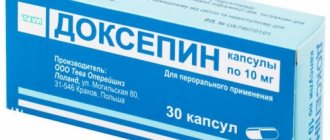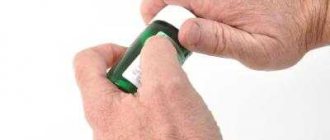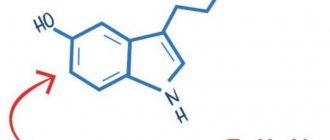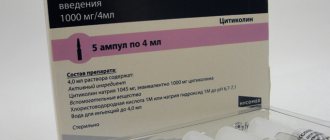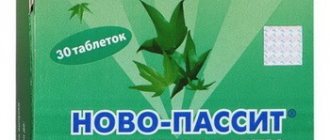| Carbamazepine | |
| Carbamazepinum | |
| Chemical compound | |
| IUPAC | benzo [1]benzazepine-11-carboxamide |
| Gross formula | C₁₅H₁₂N₂O |
| Molar mass | 236.26858 g/mol |
| CAS | 298-46-4 |
| PubChem | 2554 |
| DrugBank | APRD00337 |
| Classification | |
| Pharmacol. group | antiepileptic drugs, mood stabilizers |
| ATX | N03AF01 |
| Pharmacokinetics | |
| Bioavailable | 80 % |
| Metabolism | liver (via cytochrome CYP3A4) |
| Half-life | first dose: 25−65 hours (on average about 36 hours) repeated doses: 12−24 hours. |
| Excretion | 72% in urine, 28% in feces |
| Dosage forms | |
| • tablets, including modified release (200 and 400 mg), • syrup (100 mg/5 ml) | |
| Other names | |
| "Zeptol", "Carbalepsin retard", "Tegretol", "Finlepsin" | |
| Carbamazepine at Wikimedia Commons | |
Carbamazepine
is an antiepileptic drug from the group of carboxamide derivatives. Mainly used as an anticonvulsant for grand mal seizures (tonic-clonic seizures) and focal psychomotor epilepsy. It has a normothimic effect to a moderate extent. The mechanism of action of carbamazepine is not fully understood, but in general it is similar to antiepileptic drugs of the group of hydantoin derivatives (diphenylhydantoin, phenytoin).
Carbamazepine is included in the list of vital and essential drugs [1]. In the anatomical and therapeutic classification, it is registered under the code N03AF01.
Content
- 1 Properties and receipt
- 2 History
- 3 Pharmacology 3.1 Pharmacodynamics
- 3.2 Pharmacokinetics
- 3.3 Interaction with other drugs
- 7.1 General
- 8.1 Carbamazepine and seizures
General information
This drug is an anticonvulsant drug produced by the manufacturer only in tablet form.
This medication can be purchased at any hospital pharmacy at a price of about 60 rubles, depending on the owner’s markup. Any analogue of “Carbamazepine” (reviews of which are both positive and negative) costs many times more. Their price category starts from 200 rubles for a similar dosage of the active ingredient.
Properties and getting
According to its physical properties, carbamazepine is a white crystalline powder, practically insoluble in water (18 mg/l at a temperature of 25°C), soluble in ethanol, propylene glycol, acetone and other organic solvents. Melting point 190.2 °C.
Structurally, carbamazepine is close to tricyclic antidepressants (for example, it is structurally similar to imipramine).
In finished dosage forms, carbamazepine can be presented in the form of a dihydrate.
Synthesis of carbamazepine[2]:
Preventing migraines with medications
The use of medications to prevent migraine attacks is indicated only for frequent (two or more per month) and severe attacks and, therefore, this is necessary only for a small (no more than 10%) part of patients.
In most cases, the duration of treatment is several months. Groups of pharmacological drugs used to prevent migraine: - beta blockers; - tricyclic and tetracyclic antidepressants; - calcium channel blockers; - anticonvulsants; - non-steroidal anti-inflammatory drugs; - serotonin antagonists.
Story
Carbamazepine was discovered in 1953 by chemist Walter Schindler in Basel (Switzerland)[3]. In 1960, Schindler developed a method for the synthesis of this drug; antiepileptic properties were discovered later.
In 1962, carbamazepine became the first drug on the market to treat trigeminal neuralgia. It was used as an anticonvulsant in the UK in 1965 and was approved in the US in 1974.
In 1971, Doctors Takezaki and Hanaoka first used carbamazepine in the treatment of manic syndromes in patients refractory to antipsychotics (lithium drugs were not available in Japan at that time). Dr. Okuma, working independently, successfully used the drug for the same purposes. These two studies noted both the drug's antiepileptic properties and its anti-aggression properties. Therefore, throughout the 1970s, carbamazepine was also investigated for the treatment of bipolar disorders[4].
In Russia, carbamazepine as a drug was first registered in May 1997 under the number 97/167/1 and is currently widely represented on the pharmaceutical market under various trade names, as well as in the form of generics.
Pharmacology
Pharmacodynamics
The mechanism of pharmacological action of carbamazepine has not been fully studied. According to one of the main versions, it is associated with blocking sodium channels in the membranes of neurons in the central nervous system, which allow nerve cells to generate action potentials. In this case, carbamazepine presumably interacts with receptors associated with slow sodium channels, thereby blocking their activation. A decrease in the number of sodium channels available for activation (therapeutic concentrations of the drug removes about half of the channels from interaction) increases the threshold of neuronal excitability [5]. Thus, carbamazepine reduces synaptic conduction of impulses and prevents the occurrence of serial neuronal discharges, thereby increasing the seizure threshold and reducing the risk of developing an epileptic attack. Diphenylhydantoin has a similar mechanism of action, although carbamazepine has a more pronounced effect on the channels.
The effect of carbamazepine may also be associated with increased conductivity of chloride channels, expressed in a short-term effect on the α1, β2, γ2 subunits of GABAA receptors associated with these channels. Phenytoin has the same, although more pronounced, mechanism of action [6].
Other possible modes of action of carbamazepine that determine its anticonvulsant effect have been suggested: reducing the release of the excitatory neurotransmitter glutamate, increasing the conductance of potassium channels or modulating voltage-gated calcium channels [7].
Pharmacokinetics
Carbamazepine, entering the liver, triggers the induction of expression of the hepatic microsomal enzyme system CYP3A4, which, in turn, metabolizes carbamazepine [8]. After starting carbamazepine therapy, its concentrations are predictable (corresponding to the half-life) and individual for each patient. However, once a sufficient amount of carbamazepine has appeared in the liver tissue, CYP3A4 activity increases, accelerating the clearance of the drug and shortening the half-life. Autoinduction will continue with subsequent dose increases, but typically a plateau is reached within 5 to 7 days of the maintenance dose. Dose increases of 200 mg every 1 to 2 weeks will likely be necessary to achieve stable anticonvulsant effects. Steady-state concentrations of carbamazepine usually accumulate within 2–3 weeks after initiation of therapy[9].
In patients with genetic polymorphisms, carbamazepine metabolism changes, for example, carriers of the SCN1A IVS5-91G>A and EPHX1 c.337T>C allele require higher doses of carbamazepine. In addition, multiple regression models of carbamazepine dose concentrations have also shown that genetic variants in the SCN1A, EPHX1 and UGT2B7 genes interactively influence dose concentrations[10].
Interaction with other drugs
Carbamazepine can be prescribed in combination with other antiepileptic drugs. Carbamazepine should not be prescribed simultaneously with irreversible monoamine oxidase inhibitors (nialamide, etc.) due to the possibility of increased side effects [11]. Phenobarbital and hexamidine weaken the antiepileptic activity of carbamazepine. The competitive use of propoxyphene with carbamazepine may slow down the metabolism of carbamazepine, resulting in increased concentrations of the latter in the blood and increased toxicity[12][13].
Interaction with other drugs
The toxic effect of Carbamazepine is enhanced when taken simultaneously with: isoniazid, methoxyflurane, general anesthesia, oral contraceptives, alcohol, diuretics, antidepressants, haloperidol, pimozide, paracetamol.
Article on the topic: Find out why your knees hurt at night?
The effect of the drug is enhanced when taken simultaneously with: phenytoin, mephenytoin, isotretinoin, verapamil, fluoxetine, danazol, nicotinamide, macrolides, loratadine.
The effect of the drug is weakened when taken simultaneously with: pyramidon, phenobarbital, theophylline, rifampicin, clonazepam.
Carbamazepine weakens or completely cancels the effect of: clonazepam, corticosteroids, doxycycline, estrogen, anticoagulants, antidepressants, dihydroperidones, risperidone, tramadol.
Application
Carbamazepine is used for psychomotor epilepsy, severe seizures, mixed forms (mainly with a combination of grand mal seizures with psychomotor manifestations), local forms (post-traumatic and postencephalitic origin). It is not effective enough for minor seizures[14].
The drug is used to prevent the development of convulsive seizures in alcohol withdrawal syndrome (in a hospital setting), facial muscle spasms in trigeminal neuralgia, glossopharyngeal neuralgia, pain syndrome in diabetic neuropathy, diabetes insipidus of central origin, polyuria and polydipsia of a neurohormonal nature [13].
Carbamazepine is also used in the treatment of mood disorders[15]. According to available data, the drug is effective in manic-depressive states, and its effect is more pronounced in manic syndrome than in depression. At the same time, it has a preventive effect against attacks of depression. In some cases, carbamazepine is more effective than lithium preparations and less toxic. When combined with lithium, neurotoxic side effects may increase[16].
There is currently ongoing research into the effectiveness of carbamazepine in the treatment of indiscriminate, inappropriate sexual behavior in frontotemporal dementia[17].
Beta blocker drug for migraine prevention: Propranolol
Contains the active substance - nadolal - a non-selective beta-blocker of prolonged action. It is used in an initial dose of 40 mg; if necessary, the dose of the drug can be increased to 160 mg.
Side effects: slow heart rate, atrioventricular block, bronchospasm, heart failure, dizziness, nausea, allergic skin reactions. Contraindications: 2-3 degree atrioventricular block, slow heart rate below 55 beats per minute, acute and chronic heart failure, Raynaud's disease, severe liver and kidney dysfunction, diabetes mellitus, pregnancy.
Release form: tablets of 40 and 80 mg.
Side effects
Hyperhidrosis, double vision, hypersomnia, stupor, stomach upset, flatulence.
The drug is usually well tolerated [ source?
]. In some cases, loss of appetite, nausea, and rarely vomiting, headache, drowsiness, ataxia, and disturbance of accommodation are possible. A decrease or disappearance of side effects occurs when the drug is temporarily stopped or the dose is reduced. There is also evidence of allergic reactions, leukopenia, thrombocytopenia, agranulocytosis, hepatitis, skin reactions, and exfoliative dermatitis. If these reactions occur, stop taking the drug [13].
The possibility of the occurrence of mental disorders in patients with epilepsy who have undergone treatment with carbamazepine should be taken into account.
During treatment with carbamazepine, it is necessary to systematically monitor the blood picture. It is not recommended to prescribe the drug during pregnancy[13].
Carbamazepine causes harmful side effects ranging from 33-50%, although most of these side effects are mild, transient and reversible. Carbamazepine hyponatremia is a well-described side effect and may be responsible for some of the other side effects of carbamazepine. Numerous clinical studies have examined possible risk factors such as age, carbamazepine dose (level), polypharmacy, and carbamazepine dose (level) and polypharmacy (but not age) have been identified as predisposing risk factors for hyponatremia. The mechanism of the antidiuretic effect of carbamazepine is not yet clear. The most likely mechanism involves changes in either the sensitivity or the site of the osmoreceptor[19].
Carbamazepine interferes with the absorption of biotin (vitamin H) into the gastrointestinal tract, which is of great importance for the process of growth and absorption of fats, carbohydrates and proteins. A lack of biotin in the body can lead to dangerous complications, such as neurological disorders, and sometimes death[20]:156.
Adverse events
Side effects of Carbamazepine include a number of reactions from the central nervous system. Some people experience headaches, dizziness and sleepiness. Sometimes patients note weakness, tremors and paresis, dyskinesia and weakness of muscle tissue. There is a possibility of neuritis, dysarthria, tics, and nystagmus. It is noted that some hallucinated, became depressed, lost appetite, became anxious and became aggressive during treatment. There is a possibility of disorientation, exacerbation of psychosis, and excessive agitation.
Side effects of Carbamazepine include an allergic reaction. There is a possibility of developing increased sensitivity in several internal organs at once. In a minimal percentage of cases, the drug provoked aseptic meningitis, anaphylactic response, Quincke's edema, shortness of breath and fever, and pneumonia. Possible negative effects on the hematopoietic system, deterioration of stool, and gastrointestinal activity. Some people have dry mouth, stomach pain, and inflammation of the tongue. The activity of liver enzymes may increase. There is a risk of cardiac dysfunction, thrombophlebitis, collapse, and fainting. In the case of ischemia, there is a danger of exacerbation of the condition.
Dosage regimen
Basics
Prescribed orally (during meals) or after meals for adults, starting with 0.1 g (1/2 tablet) 2-3 times a day, gradually increasing the dose to 0.4-1.2 g (2-6 tablets) per day. day[13].
The average daily dose for children is 20 mg per 1 kg of body weight, that is, on average, up to 1 year of age from 0.1 to 0.2 g per day; from 1 year to 5 years 0.2-0.4 g; from 5 to 10 years - 0.4-0.6 g; from 10 to 15 years - 0.6-1 g per day [21].
For hyperkinesia
There is evidence of the effectiveness of the drug in a number of cases in patients with various hyperkinesis. The initial dose of 0.1 g was gradually (after 4-5 days) increased to 0.4-1.2 g per day. After 1-4 weeks. the dose was reduced to 0.1-0.2 g per day, then the same doses were prescribed daily or every other day for 1-2 weeks[21].
For trigeminal neuralgia
Carbamazepine is prescribed for trigeminal neuralgia, starting with 0.1 g 2 times a day, then the dose is increased by 0.1 g per day if necessary to 0.6-0.8 g (in 3-4 doses). The effect usually occurs 1-3 days after the start of treatment. After the pain disappears, the dose is gradually reduced (to 0.2-0.1 g per day). The drug is prescribed for a long time; If the drug is discontinued prematurely, the pain may recur. Currently, carbamazepine is considered one of the most effective drugs for this pathology[21].
Kinetics: how does it all happen?
Regardless of the dosage, Carbamazepine is transformed when passing through the liver. The dominant process option is epoxy. One active metabolite and one reaction product are formed that do not affect the human body. Also, a metabolite is formed in small quantities, which has a very weak effect on the body. There is a possibility of indicating autometabolism.
As studies have shown, the half-life of the active compound with a single dose of the drug varies in the range of about 36 hours, the maximum limit is 65 hours. When taken again, the period reaches 12-24 hours. If a person is treated with multiple drugs in combination to raise the seizure threshold, the half-life varies around 9-10 hours.
The drug is predominantly excreted in the form of inactive transformation products. Up to a third of the total dose leaves the body through the intestinal tract, other amounts - with urine. Establishing when, to whom and from what “Carbamazepine” helps, it was not possible to identify specific kinetic features in the elderly. It has not yet been possible to collect enough reliable information about the kinetics of the drug in the event that patients have impaired liver and kidney function.
Scientific research
Carbamazepine and seizures
A study was carried out on 480 patients with partial and secondary generalized epileptic seizures. Patients were randomly assigned to receive either carbamazepine or valproate for 1 to 5 years. The effectiveness of both drugs in the treatment of generalized epileptic seizures was almost identical, and in the treatment of complex partial seizures, carbamazepine was more effective than valproate in four of the five parameters assessed:
- By total number of attacks
- Number of attacks per month
- Duration of remission period
- Intensity of convulsive attacks.
The total number of patients in remission after testing with carbamazepine was 34% (75% for generalized tonic-clonic seizures, 62% for complex partial seizures).
This led to the conclusion that carbamazepine and valproate can be used with equal effectiveness in the treatment of secondary generalized epileptic seizures, but for complex partial seizures, carbamazepine is more effective [22].
Carbamazepine and bipolar disorder
A study examining the effect of haloperidol on acute mania in 2022 patients showed that there was no significant difference in the effectiveness of haloperidol, risperidone, olanzapine, carbamazepine and valproate, but there was a higher incidence of movement disorders with haloperidol [23]. .
Carbamazepine and the trigger zone of trigeminal neuralgia
To investigate the relationship between the effectiveness of carbamazepine and the presence of a trigger zone for the diagnosis of trigeminal neuralgia, carbamazepine was administered to 61 patients suspected of having trigeminal neuralgia. All patients were examined using magnetic resonance imaging or computed tomography. The final diagnosis was made by an oral and maxillofacial surgeon and a neurosurgeon. Of the 61 patients, 50 were definitively diagnosed with trigeminal neuralgia and 6 with atypical facial pain. Carbamazepine was effective as an analgesic in 45 of 50 patients (90%) with trigeminal neuralgia and 5 of 11 patients (45%) with other conditions. However, carbamazepine has relieved pain in some patients who do not have trigeminal neuralgia. In 30 of 31 patients (97%) with a specific trigger zone and in 20 of 30 (67%) without a trigger zone, trigeminal neuralgia was diagnosed, which led to the conclusion that the effectiveness of carbamazepine is an auxiliary indicator of trigeminal neuralgia, and the presence of a specific trigger zone is a strong indicator[24].
Dosage forms
As of 2012, there are various brands of carbamazepine on the pharmaceutical market in Russia: “Zeptol”
from
Sun Pharmaceutical Industries
(India),
Tegretol
from
Novartis
(France),
Finlepsin
from
Pliva
(Poland), as well as many generics produced in Russia, Canada, India and China with a significant price range.
Carbamazepine is mainly available in the form of 200 mg tablets (Tegretol is also available in 400 mg tablets). In addition, the pharmaceutical company Novartis
produces carbamazepine in the form of a 100 mg/5 ml syrup (under the same brand name) for use in pediatrics[7].
A number of manufacturers produce modified-release dosage forms of carbamazepine - extended-release tablets (retard) of 200 and 400 mg. In addition to the trademarks “Zeptol”, “Tegretol CR” and “Finlepsin retard” from the above manufacturers, this formulation is also produced by the Russian enterprise Akrikhin KhFK OJSC under the name “Carbalepsin retard”
. An important advantage of the prolonged form is that it can be taken 1-2 times a day (usually once at night). In some patients, when switching to retard tablets, dosage adjustment may be required, although usually there is no need to increase the dose.
Developers of modified dosage forms indicate that the prolonged dosage form ensures the maintenance of a more stable concentration of carbamazepine in the blood without “peaks” and “troughs”, which, according to their data, makes it possible to increase the effectiveness of therapy even when using relatively low doses, as well as reduce the frequency and severity of complications associated with a sharp increase in the level of plasma concentration of the drug (such as dizziness, drowsiness, loss of coordination, etc.).
However, according to the results of an independent meta-analysis of the results of ten clinical studies conducted, it was found that only one of them showed statistically significant differences between the long-acting and regular forms of carbamazepine, expressed in a decrease in the number of attacks in patients who were prescribed retard tablets. The remaining studies found no significant differences in effectiveness. And although patients taking the modified form of carbamazepine, as a rule, experienced fewer side effects (a certain decrease in their number was recorded in four out of nine trials), the authors of the analysis noted that the available data is insufficient to formulate reliable conclusions[25].
Currently, other developments of new dosage forms of carbamazepine are emerging. Thus, in December 2011, employees of the Novartis
It was reported that they had developed a method for obtaining carbamazepine nanocrystals using electrospray technology followed by annealing at high temperatures. The solubility and dissolution rate of carbamazepine nanocrystals increased significantly compared to standard particles of carbamazepine, which is poorly soluble under normal conditions. The publication states that electrospray technologies have the potential to produce dosage forms with increased bioavailability, the production techniques of which can be easily integrated into a continuous pharmaceutical manufacturing process[26].
Technical information
The 200 mg of carbamazepine contained in Carbamazepine tablets is the very ingredient that determines the activity of the drug. Also, each tablet contains additional components. To make the drug, the manufacturer used Aerosil, starch compounds, povidone and polysorbate. The preparation contains magnesium stearate. It is especially important for persons suffering from hypersensitivity or sensitivity to compounds used in the pharmaceutical industry to read the instructions in detail describing the ingredients used.
Notes
- Order of the Government of the Russian Federation of December 7, 2011 N 2199-r, Moscow // Russian newspaper. - Federal issue, 2011. - No. 5660.
- Schindler, W.; 1960, US Patent 2,948,718.
- W. Schindler, F. Häfliger.
Über Derivate des Iminodibenzyls (English) // Helvetica Chimica Acta. - 1954. - Issue. Volume 37, Issue 2. - pp. 472-483. - Okuma T, Kishimoto A.
A history of investigation on the mood stabilizing effect of carbamazepine in Japan (English) // Psychiatry Clin Neurosc. - 1998. - Issue. 52(1). - P. 3-12. - PMID 9682927. - Willow M., Kuenzel EA, Catterall WA
Inhibition of voltage-sensitive sodium channels in neuroblastoma cells and synaptosomes by the anticonvulsant drugs diphenylhydantoin and carbamazepine (English) // Molecular Pharmacology. - 1984. - T. 25, No. 2. - P. 228-234. - Granger P., Biton B., Faure C.
Modulation of the gamma-aminobutyric acid type A receptor by the antiepileptic drugs carbamazepine and phenytoin (English) // Molecular Pharmacology. - 1995. - T. 47, No. 6. - P. 1189-1196. - ↑ 1 2
Search in the drug database, search options: INN -
Carbamazepine
, flags
“Search in the register of registered drugs”
,
“Search TKFS”
,
“Show lekforms”
.
Circulation of medicines
. Federal State Institution “Scientific Center for Expertise of Medical Products” of Roszdravnadzor of the Russian Federation (08/23/2010). Retrieved January 22, 2012. Archived February 3, 2012. - Pienimäki P, Hartikainen AL, Arvela P, Partanen T, Herva R, Pelkonen O, Vähäkangas K.
Carbamazepine and its metabolites in human perfused placenta and in maternal and cord blood // Epilepsia. - 1995. - PMID 7614907. - Larry A.
Applied Clinical Pharmacokinetics. — McGraw-Hill, 2008. — Vol. 2. - ISBN 978-0-8385-0388-1. - Hung CC, Chang WL, Ho JL, Tai JJ, Hsieh TJ, Huang HC, Hsieh YW, Liou HH.
Association of polymorphisms in EPHX1, UGT2B7, ABCB1, ABCC2, SCN1A and SCN2A genes with carbamazepine therapy optimization // Pharmacogenomics. - 2011. - PMID 22188362. - Lexi-Comp.
Carbamazepine.
The Merck Manual Professional
(February 2009). Archived November 18, 2010. Retrieved on May 3, 2009. - eMedicine - Toxicity, Carbamazepine. Archived from the original on August 4, 2008.
- ↑ 1 2 3 4 5
Carbamazepine.
Encyclopedia of drugs and pharmaceutical products
. Radar Patent. — Instructions, application and formula. - Carbamazepine. The American Society of Health-System Pharmacists
. Retrieved April 3, 2011. Archived February 3, 2012. - Rao JS, Bazinet RP, Rapoport SI, Lee HJ.
Chronic administration of carbamazepine down-regulates AP-2 DNA-binding activity and AP-2alpha protein expression in rat frontal cortex // Biol Psychiatry. - 2007. - PMID 16806101. - Ceron-Litvoc D, Soares BG, Geddes J, Litvoc J, de Lima MS (January 2009). "Comparison of carbamazepine and lithium in the treatment of bipolar disorder: a systematic review of randomized controlled trials." Hum Psychopharmacol 24
(1):19–28. DOI:10.1002/hup.990. PMID 19053079. - Poetter CE, Stewart JT.
Treatment of indiscriminate, inappropriate sexual behavior in frontotemporal dementia with carbamazepine // J Clin Psychopharmacol. - 2012. - PMID 22217950. - De Vriese AS, Philippe J, Van Renterghem DM, De Cuyper CA, Hindryckx PH, Matthys EG, Louagie A.
Carbamazepine hypersensitivity syndrome: report of 4 cases and review of the literature // Medicine. - Baltimore, 1995. - PMID 7760721. - Gandelman MS.
Review of carbamazepine-induced hyponatremia // Prog Neuropsychopharmacol Biol Psychiatry. - 1994. - PMID 8208974. - Interaction of drugs and the effectiveness of pharmacotherapy / L. V. Derimedved, I. M. Pertsev, E. V. Shuvanova, I. A. Zupanets, V. N. Khomenko; edited by prof. I. M. Pertseva. - Kharkov: Megapolis Publishing House, 2001. - 784 p. — 5000 copies. — ISBN 996-96421-0-Х.
- ↑ 1 2 3
Carbamazepine.
Encyclopedia of drugs and pharmaceutical products
. Radar Patent. — Instructions, application and formula. - Richard H. Mattson, MD, Joyce A. Cramer, B.S., Joseph F. Collins, Sc.D., and the Department of Veterans Affairs Epilepsy Cooperative Study No.
264 Group*. A Comparison of Valproate with Carbamazepine for the Treatment of Complex Partial Seizures and Secondarily Generalized Tonic–Clonic Seizures in Adults // N Engl J Med. - 1992. https://www.nejm.org/doi/full/10.1056/NEJM199209103271104 - Cipriani A, Rendell JM, Geddes JR.
Haloperidol alone or in combination for acute mania // Cochrane Database Syst Rev. - 2006. - PMID 16856043. - Sato J, Saitoh T, Notani K, Fukuda H, Kaneyama K, Segami N.
Diagnostic significance of carbamazepine and trigger zones in trigeminal neuralgia // Oral Surg Oral Med Oral Pathol Oral Radiol Endod. - 2004. - PMID 14716252. - Powell G., Saunders M., Marson AG
Immediate-release versus controlled-release carbamazepine in the treatment of epilepsy // Cochrane Database of Systematic Reviews 2010, Issue 1. - Art. No.: CD007124. DOI: 10.1002/14651858.CD007124.pub2. - Wang M, Rutledge GC, Myerson AS, Trout BL.
Production and characterization of carbamazepine nanocrystals by electrospraying for continuous pharmaceutical manufacturing // J Pharm Sci. - 2011. - PMID 22189503.

